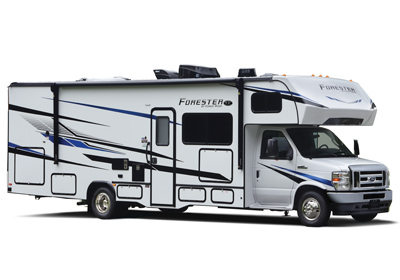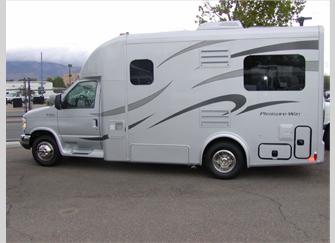Hold my beer....

This gif.... but replace penis enlarger pumps with RVs.
All tolled, I have probably spent nearly 1/3 of my life in an RV of some sort including several years as a full-timer. This sort of thing is my bag, baby.
You first need to determine what type of camping you'll be doing. For instance if you're road tripping, a motorhome is nice. As has been pointed out, no, you can't really go in the back and cook dinner on the road, but its easy enough to stop at a rest area and make a meal. If you plan on going somewhere and setting up camp for the weekend and sight-seeing, a towable RV is often prefered. Park the trailer and you have a vehicle to go do things. With a motorhome, you have to completely break camp to move it which often includes water, electric, and sewer.
DOT laws (although no one really checks) don't allow for the NPG tank valve to be open on the road, but everyone does it. Most modern RVs have fridges that will work on 120v, 12v, or propane, so there is no need to have the tank open these days.
In your search, you'll find many types.
Towable
- Pop up. Pretty typical of what you would think. They are inexpensive, but require a significant amount of setup, little protection from extreme temps, and not much more privacy than a tent in the noise category. Pros: cheap, light, small and easy to store, tow with a minimum of vehicle. Cons: you can't use it unless you set it up, so no stopping for a pee break or meal prep. It is basically a tent with a partial hard top, so it will likely leak due to the frequent setup/teardown. There are hardside popups, that all but cure the potential for aging fabric and leaks, but they are smaller interior with sloped A-frame roofs

- Hybrid or pop out. These are usually smaller travel trailers that are full height but have a pop out bed with a canvas cover. Pros: a little more space, but not much. Cons: Same basic drawbacks as a pop up.

- Hi-Lo. These are another mix of a travel trailer and popup. They are a hardside travel trailer that the upper half is a "hat" on the lower half. Pros: full travel trailer size when cranked up, easier towing (not dragging a billboard behind you). Cons: still have to set it up to use it.

- travel trailer. Again, just what you'd think. Its a box on wheels that gets pulled by the bumper hitch. Pros: Easy to use without full setup, and just like any towable, cheaper to own. A motorhome needs registration of a heavy vehicle, inspection, insurance, etc. Depending on your state, a towable just needs an inexpensive registration and no insurance or inspection. Cons: of all the towables, this one needs the most tow rig. With a TT, it's not so much about the weight and the tow capacity of the vehicle, its that you're towing a billboard and the hitch pivot point is 3' behind the rear axle. Cross winds and trucks passing mean that you often need a more beefy tow rig to avoid the tail wagging the dog.

- 5th wheel. These use the hitch plate that is similar to an 18-wheeler pin/plate hitch. Pros: a dream to tow since the hitch is directly over the axle. Crosswinds and trucks passing are a non-issue. Cons: limited layout options as they almost always have the bedroom in the front, requires an actual pickup truck, and the hitch system occupies a large amount of space; either in your garage when it's not installed or in the bed when it is. Also, the fact that the trailer is partly over the bed of the truck, it can limit what you haul in the bed. For instance, a 5th wheel is a no-go for me because I often load my motorcycle in the bed of the truck. That being said, there are bumper-tow dollies that let you use an SUV or car to two a 5th wheel, but then you have not only taken away the best part of towing a 5er by making it into a bumper tow, you also can't really back it up very well with multiple articulation points. (second picture below)


Motorhome
- Class A. These are the big square shoeboxes. They are often built on heavy frames like you might find under a step van, FedEx van, or School Bus. Pros: Beefy chassis, often more volume of room for a given length. Cons: no driver/passenger door, depending on the layout, engine maintenance can be a nightmare. Depending on how much you use it, it can just degrade by sitting unused.

- Class C. These are the motorhomes with a van nose and a bed above the van. Pros: often less expensive than class A. They often use over-the counter parts that you would find on any 1-ton version of the van its built on. Cons: care must be taken to get one that is adequately beefy for the weight they throw on it.

- Class B. Imagine taking a van/bus like you might find as an airport shuttle and stuffing it with RV things. It could be as simple as an upgraded conversion van, or as big as pictured below. Pros, more manueverable and aerodynamic, often cheaper registration given its weight. Cons: less room, and it's still a single-purpose motor vehicle that needs registration, insurance, and inspections.

Other
- Pickup camper or Slide-in. Pros: super compact, as easy to maneuver as the truck it's on, avoids registration and inspection since it is basically cargo. Can be unloaded at the camp site to have a vehicle for running around. Cons: limited space, requires a beefy pickup. It's important to note that slide-ins also often come in hybrid, pop-up, and hi-lo configurations as well.

On the topic of slide rooms: Ask if you really need it. Depending on the brand and vintage you end up buying, slide rooms can be frustratingly unreliable. Most of them are motorized with a crank backup, but that didn't help me when I was trying to get to a new job in another town and the gearbox more or less exploded. I couldn't go anywhere because my slide room was stuck in the out position. You'll also find that depending on how the body of the RV is flexed, there could be gaps in the seals that allow bugs, rodents, and water in.
If you select an RV with a slide room, also be very aware of the layout. My friends have an absolutely beautiful 5er with two slides in the back (one on each side) and a kitchen with an island. It is simply gorgeous, but when the slide room is in, the wall butts up to the fridge and doesn't allow the door to open. Some models block all access to important things like kitchens and bathrooms when the slides are in.
When selecting one, also look at the construction. Most of the less expensive versions have a corrugated aluminum siding. It is perfectly fine, but it doesn't take much for a branch or road debris to punch a hole in it. It also means that all the windows, doors, and other things have to seal on an uneven surface and there is often a little higher chance of water infiltration. The next step up is flat fiberglass. The best ones often have flat sheet aluminum sides. Do the research on wall construction as well. Many newer ones use aluminum studs. Cheaper and older ones use wood studs. If they start to leak, you could discover that a wood-stud wall has rotted and become full of mold before you can do anything about it. My current RV is flat-sheet aluminum with aluminum studs. It developed a leak and I started noticing a soft rotted spot in the interior paneling. The fix was super easy - just replace that spot of paneling. I knew the studs didn't rot. Mom and dad have an older trailer with wood studs. Sure enough it rotted and now the whole trailer sags behind the rear axle because it lost the integrity of the triangulation of a rigid wall.
You'll find several roof types. The most common is a wood roof with rubber sheeting. It is pretty reliable and easy to repair, but the rubber gets chalky from UV. This means two things: 1) you'll constantly be chasing down what RVers call "black streaks" which is the oxidized rubber dripping down the sides. Not the end of the world, but not especially easy to clean. 2) once a year they recommend cleaning the rubber with a special cleaner and post-cleaning treatment to maximize lifespan. You'll also find aluminum roofs. Cheap aluminum roofs are thin aluminum that is textured or corrugated. Some of these have a lot of seams and are pretty prone to leaks, and not too hard for a falling branch to punch through it. The best roofs are one-piece aluminum sheet. My current trailer is a two-piece aluminum flat sheet with a big strip of butyl tape down the seam in the middle. It has been mostly bulletproof, but it did have one leak around where the TV antenna sticks through.
Another good indicator of quality in an RV is the cabinetry. Here is the bottom line when it comes to RV marketing: They want to give you the maximum space, size, and options, while keeping it as light as possible so you can tow it with the least possible vehicle. They also realize that 95% of RVers use an RV three weekends a year; Memorial Day, 4th of July, and Labor day. This means they often use the absolute cheapest and lightest materials they can. Cabinets are often luan with a woodgrain laminate and assembled by little 1x1" chunks of pine in the corners. If you find an RV with quality cabinetry, you've probably found a good RV.
RV quality has been on the rise in the last 5 years. There were some really dark years there in from around 1999 to 2006. The economy was such that RVing wasn't a huge draw and so many RV companies went close to belly up and sold to an investment company who kept them afloat by making RVs from cardboard and prayers. My current TT is a 1992 Holiday Rambler. It is nothing short of amazing. The cabinets are made from real oak doors and oak plywood bodies. The plumbing fixtures are top notch. I am swapping it out at my lake spot for another trailer; mostly because the Rambler has been beaten hard for 25 years and there is a compromise somewhere that lets mice in. I'm not just going to retire it, though. I'll bring it home and refurb it. A good quality RV is ultimately rebuildable and worthy of it much like a classic car. Many early 2000s RVs were like a Chevy Cavalier. They fall apart fast and there is no real value in restoring it. Sometime in the late 90s, Holiday Rambler was bought by Monaco and they are but a shadow of their former glory. For that reason, I wouldn't hesitate to get a slightly older RV in good shape to get your feet wet. Another example... I had a 91 Fleetwood Wilderness that was a juggernaut. I traded it for a 2000 Fleetwood Wilderness that was a flaming pile of dung.
For that reason, I haven't really kept up on the latest brands and quality. I just find a good used one from the mid 90s and fix whatever it needs.



















































